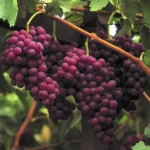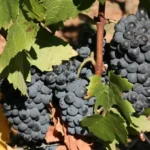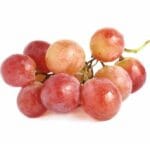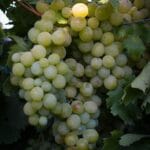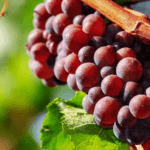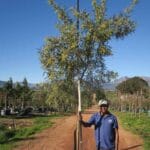Showing 973–984 of 2351 resultsSorted by popularity
- Sale!

Grape Vine Flame 10lt
Original price was: R350.00.R235.00Current price is: R235.00.Add to cartGrape Vine Flame 10lt
Harvest: End February
Red skin grape with white flesh and has no seeds. It is self pollinating and used as a table grape.
Full Sun
Afternoon Sun
Medium Watering
Deciduous
Wind Tolerant - Sale!

Grape Vine Pinotage 10lt
Original price was: R350.00.R235.00Current price is: R235.00.Add to cartGrape Vine Pinotage 10lt
Harvest: End February
Black skin grape with white flesh and has seeds. It is self pollinating and used as a wine grape.
Full Sun
Afternoon Sun
Medium Watering
Deciduous
Wind Tolerant - Sale!

Grape Vine Red Globe 10lt
Original price was: R350.00.R235.00Current price is: R235.00.Add to cartGrape Vine Red Globe 10lt
Harvest: End February
Red skin grape with white flesh and has seeds. It is self pollinating and used as a table grape.
Full Sun
Afternoon Sun
Medium Watering
Deciduous
Wind Tolerant - Sale!

Grape Vine Hannepoot White 10lt
Original price was: R350.00.R235.00Current price is: R235.00.Add to cartGrape Vine Hannepoot White 10lt
Harvest: End February
White skin grape with white flesh and has seeds. It is self pollinating and used as a table grape.
Full Sun
Afternoon Sun
Medium Watering
Deciduous
Wind Tolerant - Sale!

Grape Vine Hannepoot Red 10lt
Original price was: R350.00.R235.00Current price is: R235.00.Add to cartGrape Vine Hannepoot Red 10lt
Harvest: End February
Red skin grape with white flesh and has seeds. It is self pollinating and used as a table grape.
Full Sun
Afternoon Sun
Medium Watering
Deciduous
Wind Tolerant - Sale!

Searsia Lancea 200lt
Original price was: R6,500.00.R4,500.00Current price is: R4,500.00.Add to cartSearsia Lancea 200lt
Common Name: Karee Tree, RooikareeFull Sun
Medium Watering
Drought Resistant
Indigenous
Evergreen - Sale!

Pittosporum Viridiflorum 200lt
Original price was: R6,500.00.R4,500.00Current price is: R4,500.00.Add to cartPittosporum Viridiflorum 200lt
Common names: Cape Cheesewood, White Cape BeechFull Sun
Semi Shade
Low Watering
Evergreen - Sale!

Lagertstroemia Indica 200lt
Original price was: R6,500.00.R4,500.00Current price is: R4,500.00.Add to cartLagertstroemia Indica 200lt
Full Sun
Afternoon Sun
Medium Amounts of Water
Monthly FeedingLagerstroemia indica, commonly known as Crape Myrtle or Crepe Myrtle, is a deciduous flowering shrub or small tree that belongs to the Lythraceae family. It is native to parts of Asia, including China, Korea, and India. The plant is popular in landscaping and gardening due to its vibrant and long-lasting summer blooms, as well as its attractive bark and foliage.
Flowers
One of the standout features of Crape Myrtles is their showy flowers. The flowers are often clustered in dense, terminal panicles and come in a variety of colours including shades of white, pink, lavender, and red. The flower clusters resemble crinkled tissue paper, which gives rise to the common name “Crepe Myrtle.”Foliage
The leaves are simple, opposite, and elliptical with a smooth or slightly serrated margin. They are green during the growing season and may turn shades of red, orange, or yellow in the fall before dropping.Bark
As Crape Myrtles age, their bark peels away to reveal a smooth, mottled texture underneath. This characteristic bark is a notable feature during the winter months when the plant is leafless.Size
Depending on the variety and growing conditions, Crape Myrtles can range in size from compact shrubs to small trees. They can reach heights of 3 to 30 feet.Cultural Requirements
Lagerstroemia indica thrives in full sun and well-draining soil. It is relatively drought-tolerant once established and can tolerate a range of soil types. Proper pruning can help maintain a desired shape and promote healthy growth.Hardiness
Crape Myrtles are generally hardy in USDA hardiness zones 7 through 9, but there are newer cultivars bred to be more cold-resistant, allowing them to be grown in zone 6 as well.Disease and Pest Resistance
Crape Myrtles are generally considered relatively resistant to pests and diseases, though they can occasionally be susceptible to issues like aphids, powdery mildew, and sooty mould. - Sale!

Dombeya Rotundifolia 200lt
Original price was: R6,500.00.R4,500.00Current price is: R4,500.00.Add to cartDombeya Rotundifolia 200lt
Dombeya rotundifolia, commonly known as the Wild Pear or Pink Wild Pear, is a flowering tree native to various parts of Africa, including South Africa.
Appearance
Dombeya rotundifolia is a deciduous tree that can grow to a height of around 6 to 10m.
Its leaves are large, round, and heart-shaped, with a vibrant green colour.
The most striking feature of this tree is its clusters of pink to light mauve flowers that resemble hibiscus blooms. These flowers can cover the tree and create a spectacular display when in bloom.Cultivation
This tree is well-suited to subtropical and tropical climates.
It thrives in well-draining soil and prefers full sun to light shade.Uses
Dombeya rotundifolia is often grown for its attractive flowers, making it a popular ornamental tree.
It can be used as a focal point in gardens and landscapes, especially when its blooms are in full display.
The tree also provides habitat and food for pollinators like bees and butterflies.Maintenance
Regular pruning can help maintain the shape of the tree and encourage healthy growth.
Adequate watering, especially during establishment, is important for its initial growth phase.Dombeya rotundifolia is known for its showy blooms and ornamental value. Its large, round leaves and stunning pink flowers make it a favourite among gardeners who want to add a touch of beauty and colour to their outdoor spaces.
- Sale!

Curtisia Dentata 200lt
Original price was: R6,500.00.R4,500.00Current price is: R4,500.00.Add to cartCurtisia Dentata 200lt Tree
Common Name: Assegai; AssegaaiFull Sun
Indigenous
Medium Watering till establishedCurtisia dentata, commonly known as the Assegai tree, is a tree species in the Curtisiaceae family. It is native to Southern Africa, found primarily in South Africa, Eswatini (Swaziland), and Mozambique.
Botanical Characteristics
Leaves: The leaves of Curtisia dentata are simple, opposite, and elliptical with a glossy dark green upper surface and a paler underside. They have finely toothed margins, which is reflected in the species name “dentata.”
Bark: The bark is grey to brown and becomes rough and fissured with age. It is often used in traditional medicine.
Flowers: The tree produces small, white to creamy-yellow flowers arranged in dense clusters. These flowers are typically seen in spring to early summer.
Fruit: The fruits are small, red to dark purple drupes that attract birds and other wildlife.Growing Conditions
Climate: Curtisia dentata thrives in subtropical and temperate climates. It is commonly found in evergreen forests, along forest margins, and in moist, sheltered ravines.
Soil: The tree prefers well-drained, fertile soils rich in organic matter. It can grow in a variety of soil types but does best in loamy or sandy soils.
Watering: While it can tolerate short periods of drought, it prefers consistent moisture and benefits from regular watering, especially during dry spells.Ecological Role
Habitat: The Assegai tree is an important component of its native forest ecosystems, providing food and habitat for various bird species and insects.
Pollination: The flowers attract a range of pollinators, including bees and other insects.Uses
Timber: The wood of Curtisia dentata is hard, heavy, and durable, making it highly valued for furniture, flooring, and construction. It was traditionally used for making assegai spears, from which it gets its common name.
Traditional Medicine: The bark and leaves are used in traditional African medicine to treat various ailments, including stomach issues, respiratory problems, and infections. The bark is known for its astringent properties.
Ornamental: Its attractive foliage and flowers make it a desirable tree for ornamental planting in gardens and parks.Nutritional and Health Benefits
Medicinal Uses: Extracts from the bark and leaves are used for their anti-inflammatory, antibacterial, and astringent properties. They are often used to make decoctions and infusions in traditional medicine.
Cultivation and Management
Propagation: Curtisia dentata is typically propagated from seeds, which should be sown in a well-draining soil mix. Seeds may benefit from a period of cold stratification to improve germination rates.
Growth Rate: The tree has a moderate growth rate, with young plants requiring protection from extreme conditions until established.
Management: Pruning may be necessary to maintain a desirable shape and remove any dead or diseased branches. Regular watering and mulching can help maintain soil moisture and health.
Conservation and Environmental Importance
Soil Conservation: The tree’s root system helps stabilize soil, preventing erosion in forested areas.
Biodiversity: By providing food and shelter, Curtisia dentata supports local biodiversity and contributes to the health and stability of its ecosystem.Curtisia dentata is a valuable tree species both ecologically and economically, with its durable timber and medicinal properties. Its role in native forests and adaptability to different growing conditions make it an important species for conservation and sustainable use.
- Sale!

Buddleja Saligna 200lt
100-200lt Trees, All Plants, Export, Full Sun Plants, Hedging Plants, Indigenous Plants, Semi Shade Plants, Water Wise PlantsOriginal price was: R6,500.00.R4,500.00Current price is: R4,500.00.Add to cartBuddleja Saligna 200lt
Common Name: False OliveBuddleja saligna, commonly known as the False Olive or White Olive, is a species of flowering shrub or small tree belonging to the Buddlejaceae family. It is native to southern Africa, specifically found in countries such as South Africa, Mozambique, and Zimbabwe.
Appearance: The False Olive is a fast-growing evergreen shrub or small tree that can reach heights of about 5 to 10 meters. It has a dense, rounded canopy and pendulous branches.
Leaves: The leaves are lance-shaped or elongated, measuring around 5-12 cm in length. They are dark green on the upper side and have a silvery or greyish appearance on the lower side.
Flowers: The shrub produces fragrant, small, tubular, creamy-white flowers that are arranged in slender, elongated clusters. These flower clusters can be quite attractive to butterflies and other pollinators.
Fruit: After flowering, Buddleja saligna develops small, woody capsules containing tiny seeds.
Habitat: The False Olive is well-adapted to a variety of habitats, from coastal areas to rocky slopes and open woodlands. It is also common in disturbed areas and can be considered a pioneer species.
Uses: In some regions, Buddleja saligna has been used for various purposes. For example, the wood is occasionally used for furniture, and the leaves and bark have traditional medicinal uses. The plant is also valued for its role in attracting wildlife, particularly butterflies and birds, making it a popular choice in gardens and landscapes for biodiversity and wildlife conservation.
- Sale!

Acacia Galpinii 200lt (Monkey Thorn)
Original price was: R6,500.00.R4,500.00Current price is: R4,500.00.Add to cartAcacia Galpinii 200lt
Common Name: Monkey Thorn

